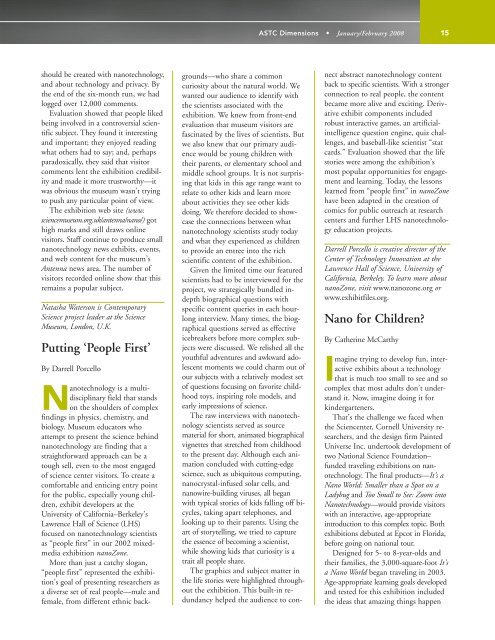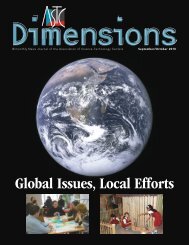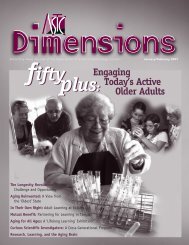Scientists Speak about Nano - Association of Science - Technology ...
Scientists Speak about Nano - Association of Science - Technology ...
Scientists Speak about Nano - Association of Science - Technology ...
Create successful ePaper yourself
Turn your PDF publications into a flip-book with our unique Google optimized e-Paper software.
should be created with nanotechnology,<br />
and <strong>about</strong> technology and privacy. By<br />
the end <strong>of</strong> the six-month run, we had<br />
logged over 12,000 comments.<br />
Evaluation showed that people liked<br />
being involved in a controversial scientific<br />
subject. They found it interesting<br />
and important; they enjoyed reading<br />
what others had to say; and, perhaps<br />
paradoxically, they said that visitor<br />
comments lent the exhibition credibility<br />
and made it more trustworthy—it<br />
was obvious the museum wasn’t trying<br />
to push any particular point <strong>of</strong> view.<br />
The exhibition web site (www.<br />
sciencemuseum.org.uk/antenna/nano/) got<br />
high marks and still draws online<br />
visitors. Staff continue to produce small<br />
nanotechnology news exhibits, events,<br />
and web content for the museum’s<br />
Antenna news area. The number <strong>of</strong><br />
visitors recorded online show that this<br />
remains a popular subject.<br />
Natasha Waterson is Contemporary<br />
<strong>Science</strong> project leader at the <strong>Science</strong><br />
Museum, London, U.K.<br />
Putting ‘People First’<br />
By Darrell Porcello<br />
<strong>Nano</strong>technology is a multidisciplinary<br />
field that stands<br />
on the shoulders <strong>of</strong> complex<br />
findings in physics, chemistry, and<br />
biology. Museum educators who<br />
attempt to present the science behind<br />
nanotechnology are finding that a<br />
straightforward approach can be a<br />
tough sell, even to the most engaged<br />
<strong>of</strong> science center visitors. To create a<br />
comfortable and enticing entry point<br />
for the public, especially young children,<br />
exhibit developers at the<br />
University <strong>of</strong> California–Berkeley’s<br />
Lawrence Hall <strong>of</strong> <strong>Science</strong> (LHS)<br />
focused on nanotechnology scientists<br />
as “people first” in our 2002 mixedmedia<br />
exhibition nanoZone.<br />
More than just a catchy slogan,<br />
“people first” represented the exhibition’s<br />
goal <strong>of</strong> presenting researchers as<br />
a diverse set <strong>of</strong> real people—male and<br />
female, from different ethnic back-<br />
grounds—who share a common<br />
curiosity <strong>about</strong> the natural world. We<br />
wanted our audience to identify with<br />
the scientists associated with the<br />
exhibition. We knew from front-end<br />
evaluation that museum visitors are<br />
fascinated by the lives <strong>of</strong> scientists. But<br />
we also knew that our primary audience<br />
would be young children with<br />
their parents, or elementary school and<br />
middle school groups. It is not surprising<br />
that kids in this age range want to<br />
relate to other kids and learn more<br />
<strong>about</strong> activities they see other kids<br />
doing. We therefore decided to showcase<br />
the connections between what<br />
nanotechnology scientists study today<br />
and what they experienced as children<br />
to provide an entree into the rich<br />
scientific content <strong>of</strong> the exhibition.<br />
Given the limited time our featured<br />
scientists had to be interviewed for the<br />
project, we strategically bundled indepth<br />
biographical questions with<br />
specific content queries in each hourlong<br />
interview. Many times, the biographical<br />
questions served as effective<br />
icebreakers before more complex subjects<br />
were discussed. We relished all the<br />
youthful adventures and awkward adolescent<br />
moments we could charm out <strong>of</strong><br />
our subjects with a relatively modest set<br />
<strong>of</strong> questions focusing on favorite childhood<br />
toys, inspiring role models, and<br />
early impressions <strong>of</strong> science.<br />
The raw interviews with nanotechnology<br />
scientists served as source<br />
material for short, animated biographical<br />
vignettes that stretched from childhood<br />
to the present day. Although each animation<br />
concluded with cutting-edge<br />
science, such as ubiquitous computing,<br />
nanocrystal-infused solar cells, and<br />
nanowire-building viruses, all began<br />
with typical stories <strong>of</strong> kids falling <strong>of</strong>f bicycles,<br />
taking apart telephones, and<br />
looking up to their parents. Using the<br />
art <strong>of</strong> storytelling, we tried to capture<br />
the essence <strong>of</strong> becoming a scientist,<br />
while showing kids that curiosity is a<br />
trait all people share.<br />
The graphics and subject matter in<br />
the life stories were highlighted throughout<br />
the exhibition. This built-in redundancy<br />
helped the audience to con-<br />
ASTC Dimensions • January/February 2008 15<br />
nect abstract nanotechnology content<br />
back to specific scientists. With a stronger<br />
connection to real people, the content<br />
became more alive and exciting. Derivative<br />
exhibit components included<br />
robust interactive games, an artificialintelligence<br />
question engine, quiz challenges,<br />
and baseball-like scientist “stat<br />
cards.” Evaluation showed that the life<br />
stories were among the exhibition’s<br />
most popular opportunities for engagement<br />
and learning. Today, the lessons<br />
learned from “people first” in nanoZone<br />
have been adapted in the creation <strong>of</strong><br />
comics for public outreach at research<br />
centers and further LHS nanotechnology<br />
education projects.<br />
Darrell Porcello is creative director <strong>of</strong> the<br />
Center <strong>of</strong> <strong>Technology</strong> Innovation at the<br />
Lawrence Hall <strong>of</strong> <strong>Science</strong>, University <strong>of</strong><br />
California, Berkeley. To learn more <strong>about</strong><br />
nanoZone, visit www.nanozone.org or<br />
www.exhibitfiles.org.<br />
<strong>Nano</strong> for Children?<br />
By Catherine McCarthy<br />
Imagine trying to develop fun, interactive<br />
exhibits <strong>about</strong> a technology<br />
that is much too small to see and so<br />
complex that most adults don’t understand<br />
it. Now, imagine doing it for<br />
kindergarteners.<br />
That’s the challenge we faced when<br />
the <strong>Science</strong>nter, Cornell University researchers,<br />
and the design firm Painted<br />
Universe Inc. undertook development <strong>of</strong><br />
two National <strong>Science</strong> Foundation–<br />
funded traveling exhibitions on nanotechnology.<br />
The final products—It’s a<br />
<strong>Nano</strong> World: Smaller than a Spot on a<br />
Ladybug and Too Small to See: Zoom into<br />
<strong>Nano</strong>technology—would provide visitors<br />
with an interactive, age-appropriate<br />
introduction to this complex topic. Both<br />
exhibitions debuted at Epcot in Florida,<br />
before going on national tour.<br />
Designed for 5- to 8-year-olds and<br />
their families, the 3,000-square-foot It’s<br />
a <strong>Nano</strong> World began traveling in 2003.<br />
Age-appropriate learning goals developed<br />
and tested for this exhibition included<br />
the ideas that amazing things happen





